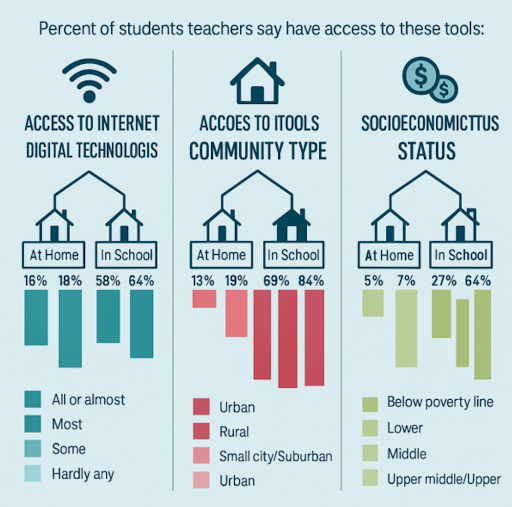One striking similarity, despite their many differences, between the trischools ISSH, Seisen, and St. Mary’s is clear: our classrooms are rapidly evolving. Laptops have replaced notebooks, and AI tools are quickly becoming the go-to resource for homework, writing feedback, and idea generation. Likewise, artificial intelligence (AI) is not some future idea for today’s students—it’s increasingly becoming a normal part of how they learn, as it slipped quietly but powerfully into students’ daily routines. While the revolutionary tool offers personalized learning and instant support, it also raises serious questions: are students learning, or just prompting? Are educators equipped to keep up? And what happens to true education when thinking can be outsourced to machines? As technologies rapidly develop in the modern world, so does the concern regarding the wise and balanced use of such tools in educational fields.
Benefits of Technology
AI technology is not just an answer-generating machine—it is a Pandora’s box that revolutionizes both the educator’s and student’s academic experiences. By streamlining administrative tasks for teachers, such as grading and lesson planning, teachers can free up time for other necessary tasks. At the same time, it empowers students with generative information, instant feedback, and adaptive pacing that adjusts to individual needs, making education more inclusive, engaging, and efficient than before.
 For instance, programs like Khan Academy’s AI tutor and Duolingo’s smart language coach use artificial intelligence to analyze student performance in real-time, adjusting lessons to each student’s level and pace. At St. Mary’s, 5th-grade teacher Mrs. Douglas uses AI programs to instantly simplify reading texts, adjust vocabulary, clarify grammar, or rewrite passages to accommodate different students. These tools not only render lessons more understandable, but they also increase engagement by allowing students to take charge of their learning. Nearly 60% of teachers say AI has improved student engagement and helped personalize instruction, according to a 2023 survey by the EdWeek Research Center.
For instance, programs like Khan Academy’s AI tutor and Duolingo’s smart language coach use artificial intelligence to analyze student performance in real-time, adjusting lessons to each student’s level and pace. At St. Mary’s, 5th-grade teacher Mrs. Douglas uses AI programs to instantly simplify reading texts, adjust vocabulary, clarify grammar, or rewrite passages to accommodate different students. These tools not only render lessons more understandable, but they also increase engagement by allowing students to take charge of their learning. Nearly 60% of teachers say AI has improved student engagement and helped personalize instruction, according to a 2023 survey by the EdWeek Research Center.
Additionally, the ISSH’s 10th-grade Social Studies class has positive views towards using AI in their learning. Describing AI as “tutor in [our] pockets”, students expressed their gratitude for such convenient tools as it would “summarize long and difficult texts into short bullet points” and “answer questions when the teacher is not with [them].” For many, this accessibility transformed how they studied, now creating less time-consuming review packets and having constant support on the screens. People revisited and reviewed material on their terms, slowly and individually in a judgement-free space, making learning feel more personal and less pressuring.
In addition to academic improvements in school, students also recognized the benefits of AI regarding time management and organization. AI-powered productivity tools like Notion, Quizlet, and Quizizz allow students to create their own study materials, such as flashcards, within a matter of minutes. According to MDPI’s study in Education Sciences, 83.5% of students interviewed believe that AI improved their learning efficiency by facilitating quick access to educational resources, reducing the time needed to find information, and helping them organize their academic activities better. For busy students juggling assignments and extracurriculars, or students who simply do not have enough time to create pages of notes, AI has become a study assistant that helps them stay on top of their workload and feel less overwhelmed.
Challenges
However, as Pandora’s box suggests, this transformation comes with potential risks such as overreliance, digital division, and fast-paced developments requiring constant adaptations. Educators’ and parents’ concerns regarding students’ overreliance on technology are well known. However, it is also necessary to question the subject: the students. An interview conducted with Jimin Suh (‘27), from the International School of the Sacred Heart, revealed that students also have growing concerns about their unintentional dependence on technology. She stated, “Sometimes I start using AI tools just to check my grammar, but then I end up rewriting whole paragraphs based on suggestions. It makes me wonder if I’m actually improving or just relying on it too much.” The blurry borders between students’ overreliance on technology and self-learning reveal a troubling trend where convenience is replaced by comprehension.
Also, the surging developments of AI technology demand constant adaptation, especially for educators. In 2022, the emergence of ChatGPT was groundbreaking to both educators and students as it was an unlimited source of information, an invention that could generate essays and answer complex questions within seconds. However, ChatGPT’s emergence was both a blessing and a curse: while it was a tool to modernize and enhance learning, it was also a crutch for the students to quickly adapt and overrely on. Likewise, this concern was exacerbated by the fact that educators could barely keep up with the pace of AI development. A 2025 report by Forbes revealed that “76% of UK educators and 69% of US educators report receiving minimal to no formal AI training from their schools,” and that “this disparity between widespread AI adoption and the insufficient preparation of educators limits educators’ ability to use AI tools effectively and responsibly.” This highlights the urgent need for bridging the gap between innovation and instruction through targeted training among educators, before it is too late. Educators also worry about the overuse of AI, as it might affect students’ critical thinking skills or lessen valuable human interaction in learning. The OECD has cautioned that excessive reliance on AI tools risks weakening students’ ability to solve problems independently and think critically.
During a Social Studies class discussion, Grade 10 students raised concerns about education shifting its focus toward who has better skills in using AI tools, rather than encouraging deep understanding and original thinking. The “tutor in [our] pockets” is developing speedily and uncontrollably, having the same—or more advanced ability to teach students than actual educators.
This question from the class discussion tackles another core concern of AI in education: if AI can teach students at the same level as educators while its usage remains nearly undetectable, are we at risk of losing the human element that makes education meaningful?
Additionally, access to AI tools remains highly unequal despite their rapid development, thus deepening the gap between those who can utilize innovations and those who cannot. While education in a single classroom should be equalized, individuals’ access to different types of technology forms a division in education. Pew Research reported that since 2021, 15% of U.S. households with school-age children do not have a high-speed internet connection, making it difficult for many students to benefit from AI resources outside the classroom. Therefore, it is essential that schools not only embrace the opportunities AI provides but also ensure equitable access, proper educator training, and guidance for students in using these tools responsibly, for it needs careful balancing to be a tool that empowers innovation without losing the essence of education.

Future Trends
Nonetheless, today’s smart tools are just the beginning—what comes next could redefine learning entirely. It is just a matter of time until there is access to personalized AI tutors and realistic simulations in classrooms, enriching the quality and depth of education for both students and educators. For example, numerous companies such as Verizon, one of the largest global telecommunications companies, are heavily investing in “[expanding] learning beyond the classroom” through augmented reality (AR) and virtual reality (VR) experiences. From a third-grade student on a virtual field trip to Ancient Egypt to a medical student simulating open heart surgery, the development of extended reality (XR) technology in schools will “make learning more immersive and accessible than ever before.”
In response to information on these groundbreaking projects, Jimin (‘27) expressed great interest and hopefulness in experiencing XR technologies in her classes. She stated, “I think classes would be way more engaging and easier to understand if we could simulate and experiment with it in virtual reality. I’m thrilled to experience these upcoming educations,” expressing her enthusiasm and expectations for XR technology.
Additionally, more educational systems will be implemented to prevent students from becoming overly reliant on AI, such as the concern raised during the Grade 10 Social Studies class, where one student remarked, “College is just how well I can use ChatGPT at this point.” For example, instead of digital assignments and exams, schools could introduce oral exams, where students are assessed solely on their knowledge and ideas expressed during face-to-face discussions with their educators. This alternative way will not only solve the students’ exploitation of AI but also limit the unavoidable prejudice in classrooms, where teachers most likely accuse students of lower performance for such cheating. “There is a nasty cycle of prejudice where, although everyone uses AI, it would be easier to accuse the lower-performing student of using it.” By implementing such a system, fairness could be restored, ensuring that students are evaluated on their true abilities, while also using modern technology in other assignments, balancing the smart tools to become smarter schools.
Conclusion
Looking around classrooms now, there are noticeable differences compared to just a few years ago. Although our educational lives have become more advanced and efficient, problems such as overreliance, adaptation, and accessibility have also emerged. As AI evolves into extended reality, where students learn and engage in a virtual world, schools must do more than just adopt new tools; they must prepare students and teachers to use them wisely. This means investing in training, promoting balance, and ensuring that technology enhances rather than replacing critical thinking and creativity is necessary. Our goal isn’t to resist modern changes, but to implement them wisely, so that the new technology enriches the educational aspect of our lives.






